Water activated battery
a technology of activated batteries and water, applied in the direction of positive electrodes, electrode manufacturing processes, deferred-action cells, etc., can solve the problems of high cost, many toxic materials, early failure, etc., and achieve the effect of low cos
- Summary
- Abstract
- Description
- Claims
- Application Information
AI Technical Summary
Benefits of technology
Problems solved by technology
Method used
Image
Examples
example 1
[0057]A basic copper sulfate cathode was prepared as follows:
[0058]CuSO4.3Cu(OH)2.H2O 133.6 gm (Northern Michigan Aquatics), sulfur 34.4 gm (Aldrich), carbon black 12 gm (Cabot), sodium chloride 16 gm (Aldrich), and FEP powder 4 gm (DuPont) were weighed into a Pascal blender and blended for two hours. A 20 g sample of the mix was transferred to the cylinder of a piston and cylinder type die, wherein the cylinder had a die recess with an open area of 72.5 mm. First, 10 gm of the mix was poured into the die cylinder and leveled, then the cathode current collector (a pre-tabbed copper expanded metal sheet, approximately 20 mesh, obtained from the Exmet Corp.) was laid over this, and a further 10 g portion of mix added to the die cylinder and leveled.
[0059]The standard die was then closed with its mating piston section. The closed die was then heated to 110° C. in a 5 ton press with heated platens (PHI), and the mix pressed for four minutes. After cooling and removing the compact from t...
example 2
[0060]In order to test the performance of the cathode from Example 1, it was clamped at a uniform spacing of about 1 mm separation between two parallel magnesium anode foils of the alloy type AZ61 (Magnesium Elektron) having a common current takeoff and similar overall area dimensions to the cathode and a thickness of 1 mm. The plate assembly, with one wire proceeding from the common tab of the two magnesium plates out to a signal bulb device, and one wire from the bulb device back to the cathode tab, was immersed into tap water in a 5-liter beaker. The bulb lit immediately, emitting more than one candela of light. After 8 hours, the emitted light intensity remained above one candela, demonstrating that the battery meets aviation and nautical requirements.
PUM
 Login to View More
Login to View More Abstract
Description
Claims
Application Information
 Login to View More
Login to View More - R&D Engineer
- R&D Manager
- IP Professional
- Industry Leading Data Capabilities
- Powerful AI technology
- Patent DNA Extraction
Browse by: Latest US Patents, China's latest patents, Technical Efficacy Thesaurus, Application Domain, Technology Topic, Popular Technical Reports.
© 2024 PatSnap. All rights reserved.Legal|Privacy policy|Modern Slavery Act Transparency Statement|Sitemap|About US| Contact US: help@patsnap.com









